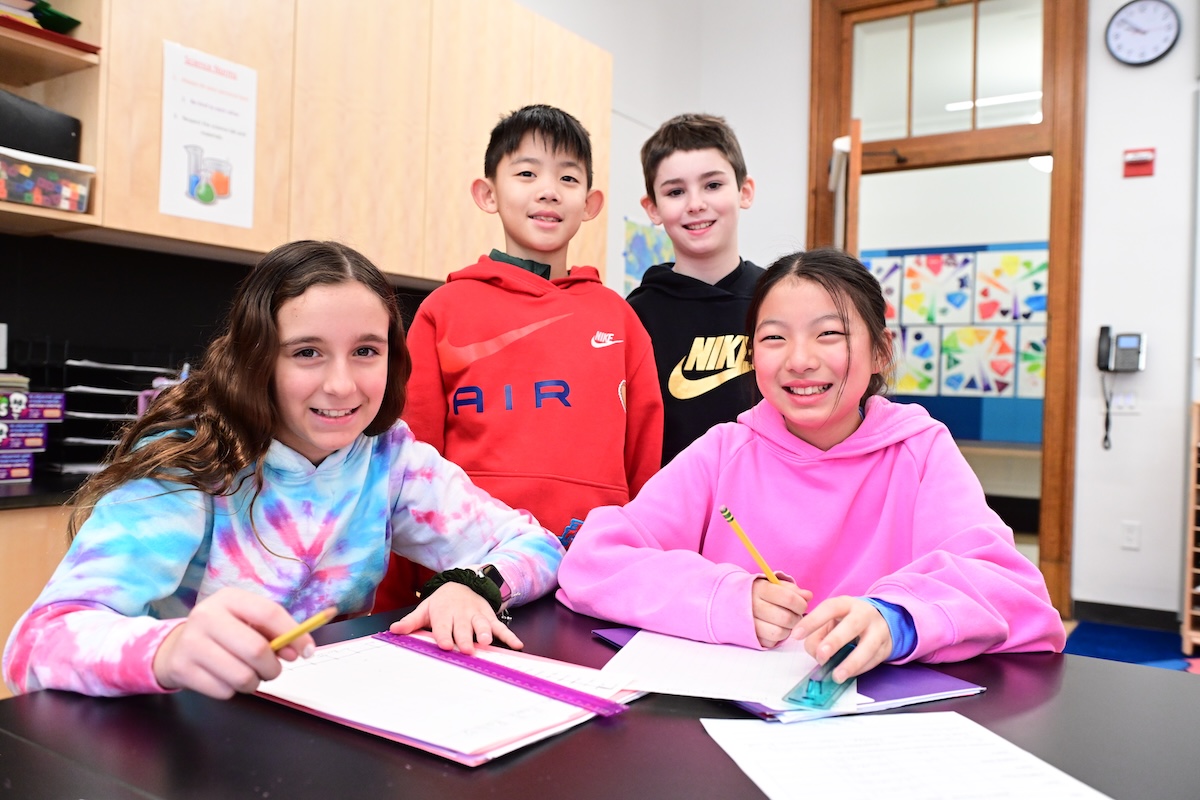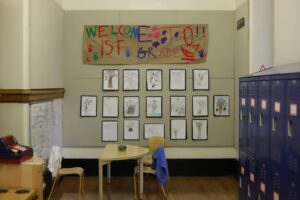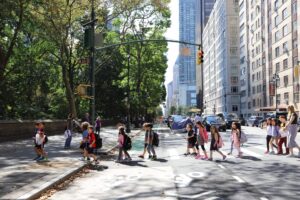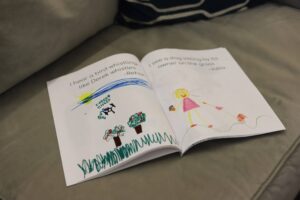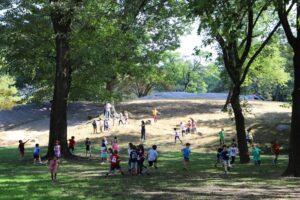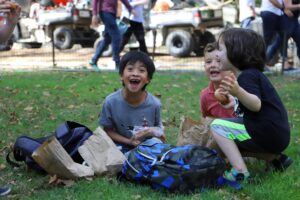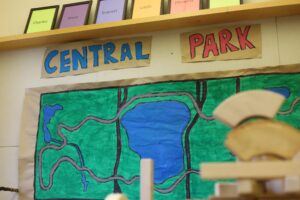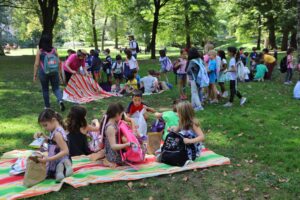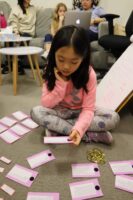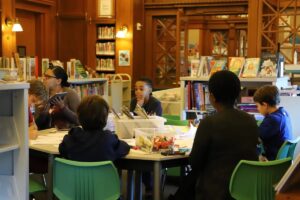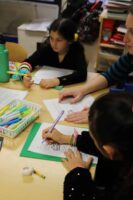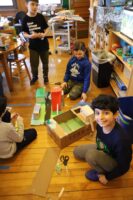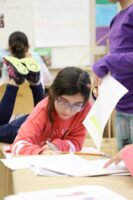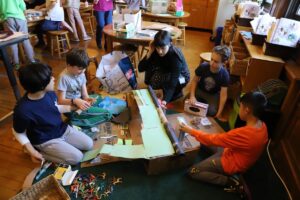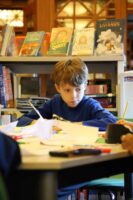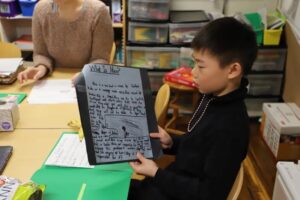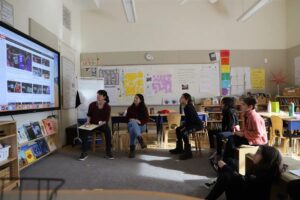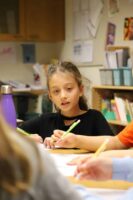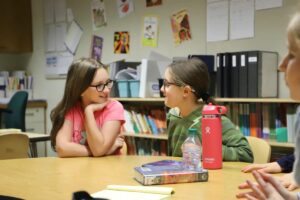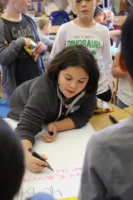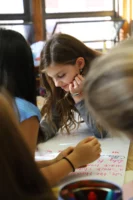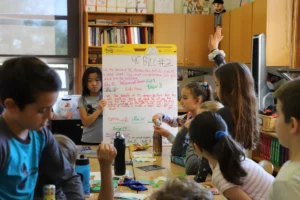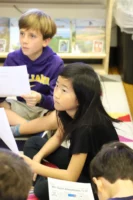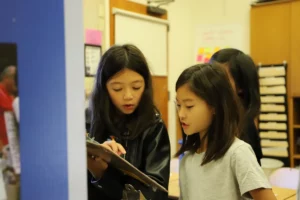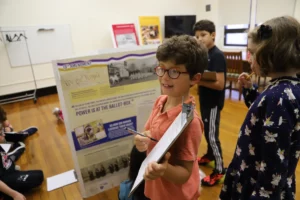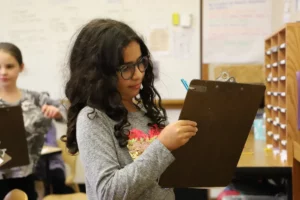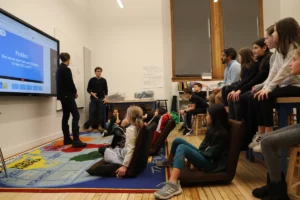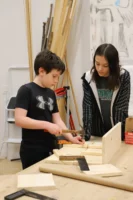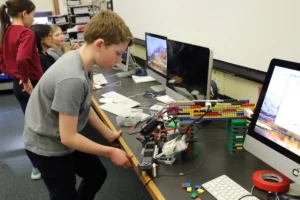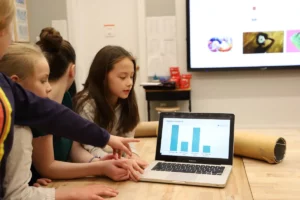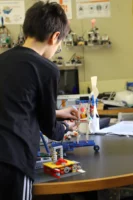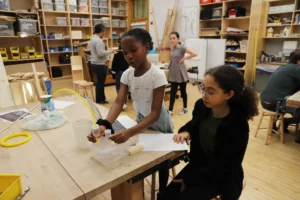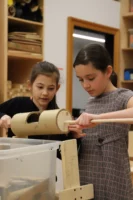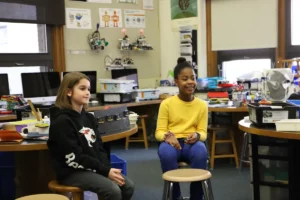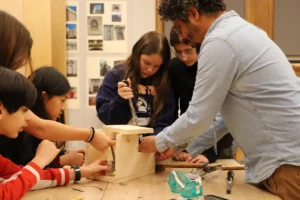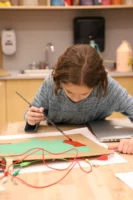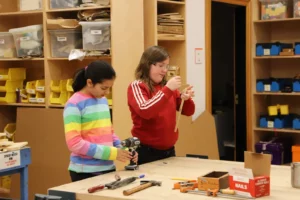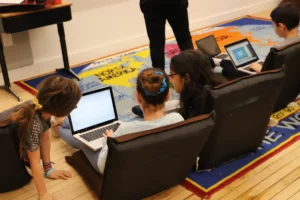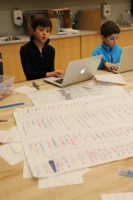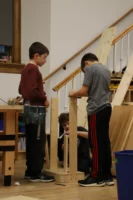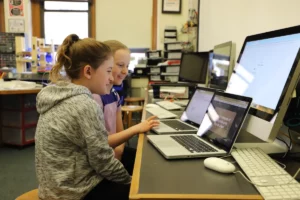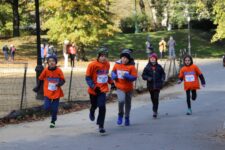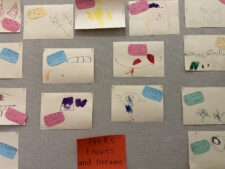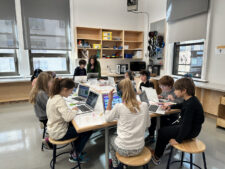Located directly across from Central Park, Ethical Culture uses its environment and surroundings as lenses to engage students in Pre-K through 5th Grade. The Social Studies curriculum provides the starting point for all subjects. Diversity, equity, inclusion, and social justice are woven into each study.
Social and academic curricula are equally important. Each grade designs its curriculum to present our students with the skills that they will need for the 21st century, specifically cognitive, interpersonal, and intrapersonal skills. Through engaging lessons and activities, students learn about each other as individuals and as members of the larger class and school community while simultaneously engaging in their studies of Math, Science, Social Studies, and Language Arts. Our constant goal is to foster their motivation, participation, and learning.
As students progress through the grades, they learn additional subjects in Specials Classes taught by teachers who specialize in a given discipline. These Specials — including Art, Ethics, Music, Physical Education, and Social Studies Workshop — complement the learning that happens in students’ homeroom classes.
Experience Ethical Culture yourself in this video!
Pre-K
Pre-K students learn to see connections, categorize information, and ask relevant questions. They acquire these skills by studying both themselves and the world outside the classroom.
Social Studies focuses on how to be an empathetic member of a community, with a specific focus on the classroom. Students share about themselves and learn about their classmates. After in-depth discussions of who we are, students move on to discussing fairness and social justice. Students define what fairness means to them and learn about children and adults who have worked or are still working to make our world a fair and just place.
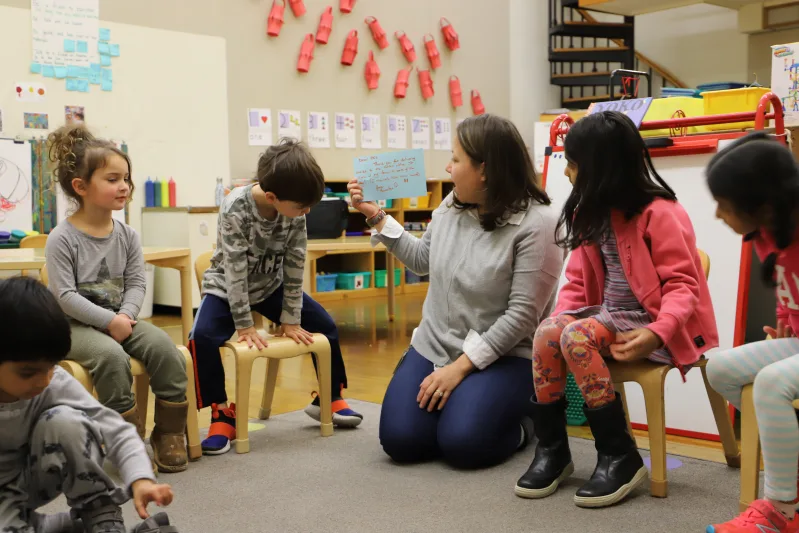
The year ends with various topics determined by student interest.
Pre-K students enjoy weekly classes with Music, Library, Physical Education, and Spanish teachers.
Kindergarten
Language Arts
Numerous literacy activities are woven throughout the Kindergarten day. Some of these activities are explicit: reading the morning question, message, or schedule; examining the numbers of letters and syllables in words; and identifying and segmenting beginning, middle, and end sounds. Many other activities — such as making signs, lists, labels, surveys, maps, notes, stories, and books — are contextual and occur through play, during student-driven work times, and during teacher-initiated tasks.
Students interact with a wide range of developmentally appropriate literature every day. They hear stories read aloud, explore books alone or with friends, and participate in discussions and predictions about books. Each week, during one or two “SLAW” (sound, letter, and word work) blocks, students at all levels develop phonemic awareness and comprehension skills and build on what they know.
Math
Kindergarteners build off their study of the School by making connections between math and the real world. With this study, students realize that shapes, numbers, and interrelationships surround us. In their study of patterns, students learn about constructing, describing, recording, and extending repeating patterns. Through games and integrated activities, students learn about magnitude by comparing, counting, and ordering quantities of materials such as wooden blocks. Students then use their understanding of number concepts to organize and design individual counting books.
Social Studies
Kindergarten Social Studies is about organizing the student’s world and making sense of interrelationships within it. Students start the year with a study of the School. They sketch the outside of the building, make dioramas of different rooms, and interview people who work in the School.
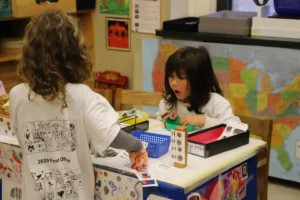
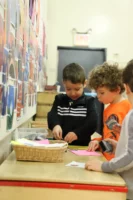
Since late February, Kindergarteners have been making, collecting, and delivering handwritten letters throughout Ethical Culture.
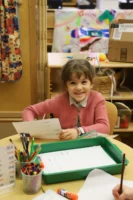
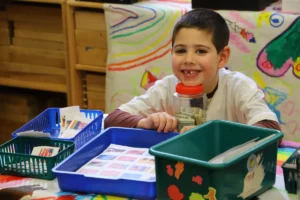
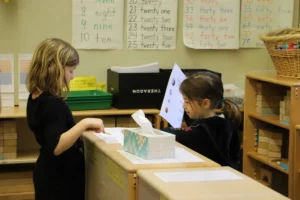
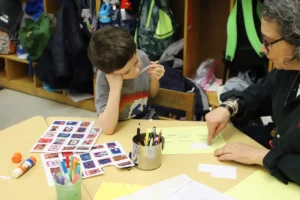
The annual Kindergarten post office tradition sees some of the School’s youngest students engage with multiple core skills as they learn to write greetings, count money, and more.
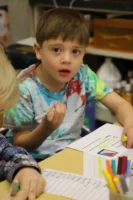
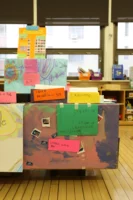
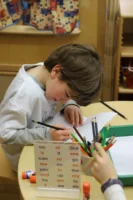
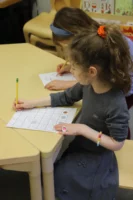
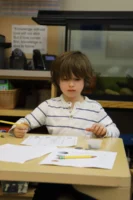
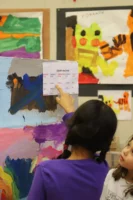
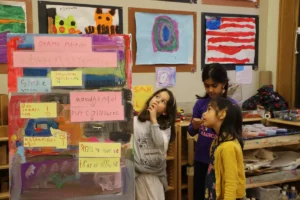
Write a postcard to a friend, child, or teacher in the building, and the Kindergarteners will be sure to deliver it — with plenty of joy and love.
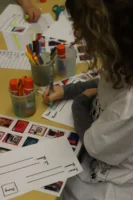
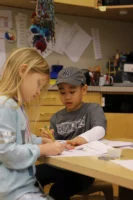
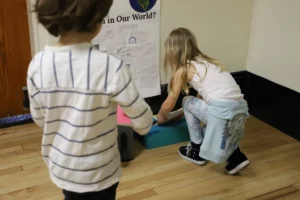
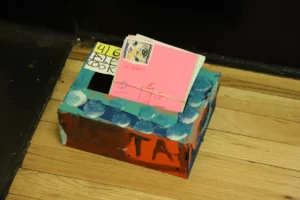
A family study follows, focusing on different family structures, interviews with family members, and the creation of a book that includes information about family members, languages spoken at home, customs, rituals, and noteworthy celebrations.
A favorite spring project is the post office. For three weeks, students and families across the School write letters. Kindergarteners make mailboxes for each classroom; design and sell postcards, letters, and stamps; and — on a daily basis — pick up, sort, and deliver the mail for the entire school.
The final Kindergarten project is an About You and Me study. Students think about their own similarities and differences and find out more about their classmates.
Specials Classes
Kindergarteners enjoy weekly classes with Music, Library, Physical Education, Spanish, and Science teachers.
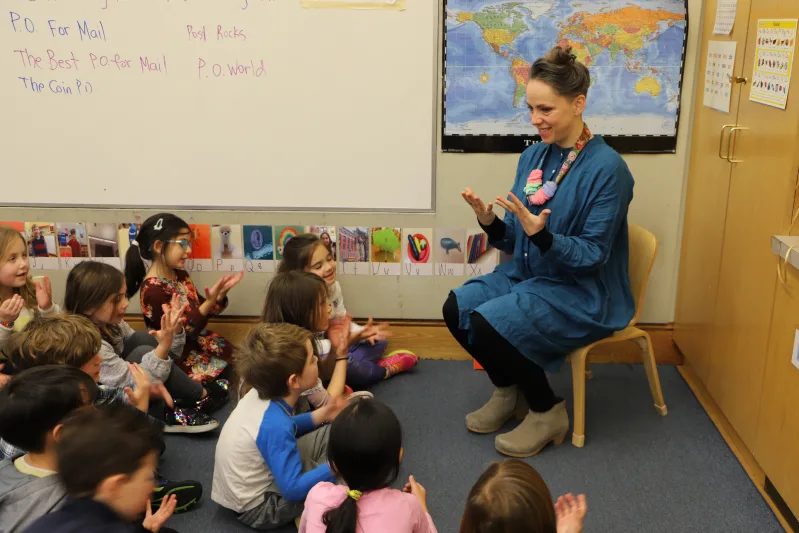
1st Grade
Language Arts
Throughout the year, 1st Graders engage in a wide variety of daily activities that develop early decoding skills, phonological knowledge, fluency, and overall comprehension of fiction and nonfiction. Through read-alouds and group conversations, students build on their understanding of story structures and text features of different types of books, as well as an overall love of literature. Students work in small reading groups to receive targeted, differentiated instruction that develops their integrated reading skills. In these groups, students practice connecting with the text, predicting, asking questions, and making meaning of what they are reading. During independent reading, teachers guide students toward books that are good fits so that students may practice reading and strengthen their skills.
Writing focuses on taking the creative ideas in students’ heads and transferring them to paper. 1st Graders learn that writing is a powerful means of communicating ideas and stories. Students engage with numerous self-directed and structured writing pieces that take them through each step of the writing process. Utilizing mentor texts, 1st Graders learn about the many ways authors bring their stories to life. Students experiment with these techniques as they add a wide range of details to their own stories. 1st Graders also learn to add structure, making sure that they include a beginning, middle, and end, with step-by-step details that create a movie in the reader’s mind. Through planning and illustrating, students learn to develop their ideas before beginning their initial drafts. Through revision, they learn to strengthen their writing and communicate more clearly. As students grow as spellers, they learn to take risks and use invented spelling while also applying the sight words and spelling patterns covered in class. Students polish their work as they continue to practice mechanics, handwriting, and overall presentation.
Math
Math occurs throughout the school day, whether in morning meeting activities, partner games, or guided explorations. Students develop their overall number sense by visualizing problems, using manipulatives and organizers, and explaining their thinking through words and pictures. Familiarity with number value comes through activities and projects that involve skip counting, estimating, graphing, and sequencing. Students become problem solvers as they practice a variety of strategies to work through context-based story problems and compute using addition and subtraction. They work with money, time, and geometry throughout the year, both through daily activities and deeper hands-on explorations, many of which revolve around real-world problem solving.
Social Studies
1st Grade Social Studies centers on building empathy and compassion by understanding multiple points of view.
Students begin the year with a focus on My Story: an in-depth study of aspects of their identity and identity expression. They then use what they learn to begin looking at Your Story: how oral traditions and multiple perspectives help us understand another person’s point of view. Later in the year, students learn about Our Story: a study of change makers both past and present who have used their lives to create positive change.
In the spring, students use what they have learned about multiple perspectives to conduct their own activism. This work culminates in a project that tells a story they feel the wider community should hear.
Central Park is another focus of study. Students research the various communities that were displaced to make way for the park, leading to ethical questions about what constitutes as public good. Students take many visits to the park and use maps to plot its various features and landmarks. In Science, they examine the park’s flora and fauna. For their culminating project, students visit the boating pond, where they float boats they’ve made in Social Studies Workshop.
Specials Classes
1st Graders enjoy weekly classes with Music, Library, Physical Education, Spanish, Science, Art, and Social Studies Workshop teachers.
2nd Grade
Language Arts
The goal of the 2nd Grade Language Arts curriculum is to instill a love of reading in each student. Reading time includes independent interest-based reading, partner reading, and small-group guided reading with teachers. As a class, students learn to decode words. Students also look at the numerous ways a reader can understand, relate to, and respond to text, whether mentally, verbally, or in written work. In small groups or as partners, students “think beyond the text” by predicting, inferring, making connections, questioning, visualizing, and summarizing. They examine an author’s craft and textual structures by studying the unique elements that make up the fiction and nonfiction they read in class. Students build fluency by reading aloud to peers while paying attention to phrasing, intonation, and punctuation.
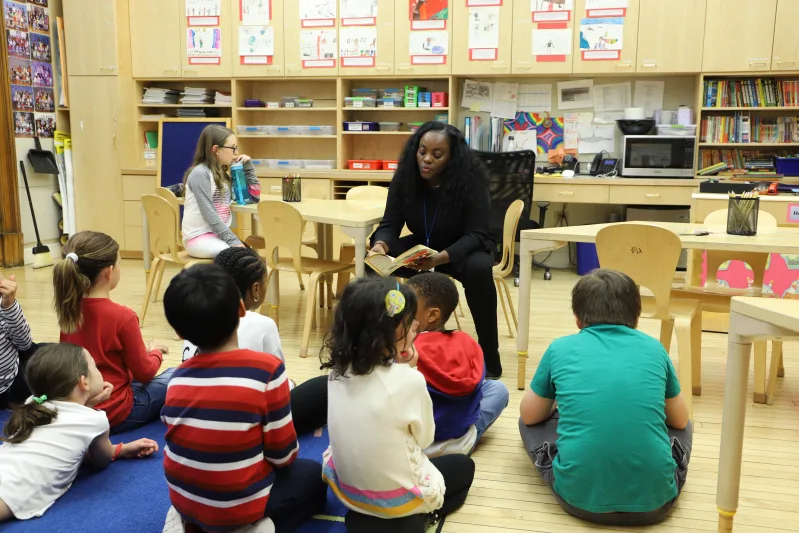
Students also learn about the progression of the writing process from brainstorming and drafting, to revising and editing, and, finally, to publishing and celebrating. Students write personal narratives in which they add dialogue and include “juicy” adjectives to enhance the beauty of their piece. Students practice a range of freewriting styles, as well as the beginnings of expository writing. 2nd Graders learn different ways to use details to further expand on ideas and opinions. The curriculum focuses on parts of speech as a means to expand a sentence and include further detail. In all of these units, students learn what it means to be an author in creating a piece of work.
Math
The Math program in 2nd Grade emphasizes the importance of hands-on experiences and exploration. Students work toward computational fluency with addition and subtraction problems. In small groups, they focus on becoming flexible, accurate, and efficient mathematicians in both communicating their thinking and recording their solutions. In their geometry unit, 2nd Graders learn about the attributes and relationships of two-dimensional shapes. The class explores time through both analog and digital clocks. Students use time-based situations in everyday life to study and understand the concept of seconds, minutes, and hours. Money acts as a tool for practicing computation in a contextual form. In all of these units, students use games and everyday experiences to deepen their understanding of math.
Social Studies
The Social Studies curriculum, Our Neighborhood and Its Basic Needs, is a study of neighborhoods and New York City that stretches across all areas of curriculum, including Language Arts, Math, Science, and Art. 2nd Graders begin the year with an exploration of personal communities, such as families and homes, and then broaden the discussion to talk about their school and neighborhood communities. Students also explore maps and scale by looking at city maps and creating their own scale maps and models. In their culminating project, students create a city in the classroom.
Specials Classes
2nd Graders enjoy weekly classes with Music, Library, Physical Education, Spanish, Science, Art, Social Studies Workshop, and Ethics teachers.
3rd Grade
Language Arts
In the fall, Language Arts focuses on writing from one’s own experiences. Projects include memoirs, personal narratives, and reflections on 3rd Grade trip experiences. Students work through the steps of the writing process, including planning, drafting, revising, editing, and publishing. In both daily work and writing projects, students learn to express themselves clearly and competently through a variety of sentence structures. 3rd Graders refine their paragraph structure and mechanics through teacher and peer conferences. Concurrently, students work in small word-study groups to review various spelling patterns, sight words, and rules.
In the spring, students use their comprehension skills to write clear, thorough chapter summaries of fictional texts. 3rd Graders also develop strategies for comprehending nonfiction, such as using nonfiction features and chunking to identify main ideas. Students develop their research skills through a project that includes fact-finding, paraphrasing, sequencing, and drafting nonfiction articles of their own. Students practice cursive writing throughout the year.
Math
3rd Graders begin to make sense of larger numbers through the thousands. Students learn to understand computation as a balance of thinking flexibly, efficiently, and accurately. They work on mastering the multi-digit addition and subtraction regrouping algorithm, relying on a wealth of efficient strategies for solving problems. Students explore multiplication as objects in a group or array and work on recalling multiplication facts automatically. They end the year with division and partial numbers, exploring where different fractions would go on a double number line and how fractions compare to one another.
Students ground themselves in the context of each mathematical situation by making reasonable estimates, checking strategies, and communicating their thinking through numbers, models, and writing. Discourse centers on debating answers and methods in partnerships, small groups, and whole class situations. Students continue to make connections between the math concepts they learn in the classroom and the real world.
Social Studies
3rd Grade Social Studies is a hands-on, integrated curriculum involving many Specials classes, including Library, Science, and Social Studies Workshop. 3rd Graders start the year with a unit on personal identity, which then segues into a larger conversation about stereotypes that different people face. Students then zoom in on the lived experiences of Native American peoples today. 3rd Graders discuss and challenge the stereotypes that Native Americans face as they attempt to be allies to this community. Through trips, historical fiction, and nonfiction, as well as group and independent projects, students learn about the Hudson River, past and present. Students study the first people of the Hudson River Valley, learning about Lenape daily life, customs, and interactions with the environment, both long ago and in the present day.
Specials Classes
3rd Graders enjoy weekly classes with Music, Library, Physical Education, Spanish, Science, Art, Social Studies Workshop, and Ethics teachers.
4th Grade
Language Arts
In 4th Grade, students learn to read fluently and understand a range of genres, including a variety of fictional and informational texts. Fictional narratives at this level have elaborate plots and complex characters who change and develop over time. Students investigate a multitude of settings, cultures, and perspectives different from their own and consider the author’s craft, including style, language, and themes. Additionally, 4th Grade readers attend to and utilize nonfiction features (e.g., captions, index, glossary) for research purposes and notice common text structures (e.g., chronological, cause and effect). They also decipher new vocabulary words, whether they are defined within the text or not.
4th Graders write for a variety of purposes. Students solidify and expand their use of paragraph structure. Students write their first expository essay based on their Social Studies research. They learn to organize their writing appropriately and hold the reader’s attention with varied sentence structures, formal voice, and focused content. Students begin to use several elements of craft, such as descriptive language and sophisticated vocabulary. They learn a variety of revision strategies throughout the year. Students are expected to use capitalization, punctuation, and grammar accurately; use a variety of writing tools (e.g., writer’s notebook, laptops, graphic organizers); and apply learned spelling patterns.
Math
Throughout the year, students apply mathematical concepts they are learning to real-world situations. Students expand their addition and subtraction strategies through the ten-thousands in practice and review activities and then apply these skills in their work with multiplication. They explore multiplicative patterns and properties, such as powers of 10 and the associative property. They learn to find factors of numbers; discover relationships between factors and their multiples; and identify characteristics of numbers such as prime, composite, and square. Students develop a variety of strategies for multiplying two- and three-digit numbers, including doubling and halving, partial products, and, by the end of the year, the standard U.S. regrouping algorithm (stacking), with an emphasis on sense-making and efficiency.
4th Graders develop an understanding of division by building on their knowledge of multiplication. They demonstrate understanding of the two types of division situations, known as quotative and partitive (chunking and sharing), and solve division problems with three-digit numbers and one- and two-digit divisors, including some that result in a remainder. In tandem with their state study in Social Studies, students create tables and graphs to represent area, population, minimum wage, and unemployment rate data. Students also find measures of central tendency, such as the median and mode, and analyze the data for trends.
Social Studies
In 4th Grade Social Studies, students begin the year by discussing the purpose of government and building a classroom community with their own class constitution. Students learn the basic structure of the three branches of government and analyze important historical documents that frame the United States, such as the Constitution and the Bill of Rights. They pay particular attention to the First Amendment. As the unit continues, 4th Graders hone vital research skills and expository writing techniques in the state research project.
In the second semester, students investigate immigration over a 350-year period, including the reasons that immigrants leave their home countries and come to the United States. They learn how the contributions of these immigrants have shaped and enriched our society over time. Students research and write expository essays and historical fiction to reflect their learning. In addition, they study major waves of immigration, such as those of the Russian Jews, Irish, Italian, Chinese, Mexican, and Japanese. Field trips offer hands-on experiences with both historical and modern-day immigration stories. Students explore questions such as “What are the factors that ‘push’ people to emigrate?”, “What are the factors that ‘pull’ immigrant groups into America?”, and “What contributions have immigrants made to American society?”
4th Graders also learn about enslaved Africans, who were brought to the United States against their will. After an introduction to the multitude of African countries and cultures, students learn about the function of the Triangle Trade, the harsh realities of the Middle Passage, the horrors of slavery in America, and the many ways that people bravely resisted enslavement.
Specials Classes
4th Graders enjoy weekly classes with Music, Library, Physical Education, Spanish, Science, Art, Social Studies Workshop, Ethics, and Computer Science teachers.
5th Grade
Language Arts
Students develop expository and narrative writing skills, progressing from single- to multi-paragraph pieces. They apply the core steps of the writing process to develop their ideas with a clear, organized, and well-crafted approach. For expository pieces, students draw from facts, concrete details, quotes, and cited examples. Students are introduced to various writing tools, such as graphic organizers and editing, revision, and peer review checklists. While responding to novels and nonfiction, students grapple with incorporating questions into their answers and providing their own analysis alongside evidence from the text. With consistent teacher feedback through each step of the process, students develop a more sophisticated approach to writing.
Math
At the start of the school year, students become fluent in multiplication and division strategies, including the standard algorithms, and apply that knowledge to calculating with increasingly large numbers. Students continue to study factors and multiples, which deepens their understanding of the relationship between multiplication and division, and they investigate surface area and volume of rectangular prisms. They apply these skills to compute means (averages), expanding their understanding of data analysis. Finally, they explore the coordinate plane and develop rules to describe lines in it.
Students investigate and identify prime, composite, square, even, and odd numbers. They use these properties to develop an understanding of prime factorization. The study of prime factorization leads to a study of exponents and the associative and distributive properties. During the final unit, students study partial numbers, moving flexibly between fractions and decimal and percent equivalents, using the appropriate notation for a specific question or situation while problem solving. Students order, compare, add, and subtract fractions, decimals, and percents, using reasoning about equivalents and the relationships between them. Students employ a variety of strategies, including common denominators, mixed numbers, and improper fractions. During a series of real-world investigations, students deepen their understanding of proportional reasoning by determining the best deal in a store, calculating the price of bulk items, and deciding if two new neighborhood playgrounds receive equitable resources.
Social Studies
5th Graders study the colonization of eastern North America, considering the impact European settlers had on Native Americans, as well as the beginning of enslavement in the original colonies. Students focus on the development of New Amsterdam, discussing both the Dutch and English influences.
In the second part of the year, students study the Civil Rights movement of the 1950s, 60s, and beyond. Students read, write about, and discuss texts and primary documents. They learn to integrate their background knowledge to understand a text and interpret characters and events. Novels and short stories develop students’ analytical skills, such as identifying how a setting impacts character development, determining the emotional atmosphere of a story, and noticing how and why characters overcome challenges.
Students develop their research skills while working with nonfiction texts. They select and navigate resources independently, take notes, paraphrase, and quote from a text. Students read novels as a class, in small book clubs, and independently.
Specials Classes
5th Graders enjoy weekly classes with Music, Library, Physical Education, Spanish, Science, Art, Social Studies Workshop, Ethics, and Computer Science teachers.
